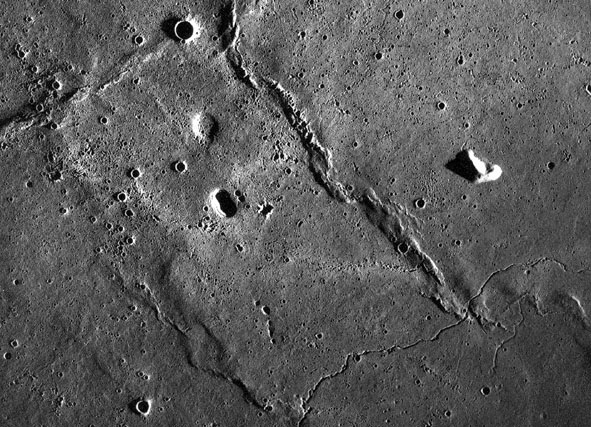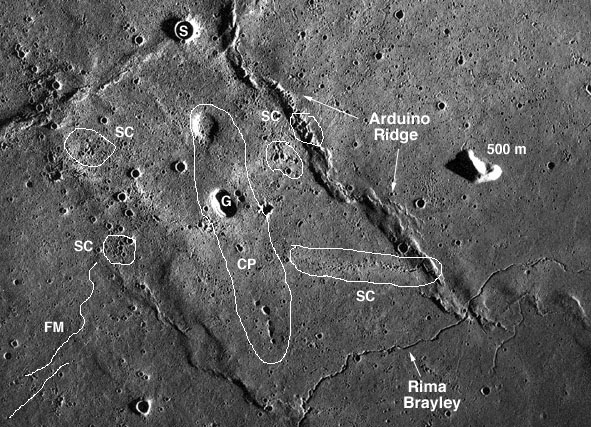Difference between revisions of "July 8, 2004"
| (8 intermediate revisions by the same user not shown) | |||
| Line 1: | Line 1: | ||
__NOTOC__ | __NOTOC__ | ||
=Magic on the Mare= | =Magic on the Mare= | ||
| + | <!-- Start of content --> | ||
<table width="85%" border="0" align="center" cellpadding="6" cellspacing="2"> | <table width="85%" border="0" align="center" cellpadding="6" cellspacing="2"> | ||
<tr> | <tr> | ||
| Line 8: | Line 9: | ||
<tr> | <tr> | ||
<td colspan="2"><div align="center"> | <td colspan="2"><div align="center"> | ||
| − | + | {{HoverImage|LPOD-2004-07-08.jpeg|LPOD-2004-07-08b.jpeg}} | |
</div></td> | </div></td> | ||
</tr> | </tr> | ||
| Line 14: | Line 15: | ||
<table width="100%" border="0" cellpadding="8"> | <table width="100%" border="0" cellpadding="8"> | ||
<tr> | <tr> | ||
| − | <td><div align="center | + | <td><div align="center"><p>Image Credit: Apollo 15 Metric Camera Frame [http://www.lpi.usra.edu/research/apollo/catalog/metric/ 1849]</p></div></td> |
</tr> | </tr> | ||
</table> | </table> | ||
| Line 21: | Line 22: | ||
<p class="story" align="left"> | <p class="story" align="left"> | ||
What a wondrous piece of the Moon! As the Apollo 15 Command Module circled the Moon its Metric Camera took 2240 images of the lunar surface. The very best, like this one near the boundary of Mare Imbrium and Oceanus Procellarum, are works of arts and inspirations for science. This 80 km wide swath of mare - which is just a quarter of the entire frame - is full of interesting features. A mare ridge snakes diagonally across the field. By comparison of the ridge's shadow and that of the 500 m high nearby peak we can guestimate that the ridge is only about 100 m high. Along the bottom right is a section of the Rima Brayley sinuous rille, which is about 250 km long but only about 500 m wide. <br> | What a wondrous piece of the Moon! As the Apollo 15 Command Module circled the Moon its Metric Camera took 2240 images of the lunar surface. The very best, like this one near the boundary of Mare Imbrium and Oceanus Procellarum, are works of arts and inspirations for science. This 80 km wide swath of mare - which is just a quarter of the entire frame - is full of interesting features. A mare ridge snakes diagonally across the field. By comparison of the ridge's shadow and that of the 500 m high nearby peak we can guestimate that the ridge is only about 100 m high. Along the bottom right is a section of the Rima Brayley sinuous rille, which is about 250 km long but only about 500 m wide. <br> | ||
| − | The dominate feature in the image is an elongate rimless pit, Brayley G. One of the very few lunar collapse pits (CP on the mouseover) to receive a designation, Brayley G is the largest of a line of pits, which probably formed by collapse over a buried lava tube. The final volcanic feature here is also the hardest to see. Along the bottom left quadrant of the image are flow margins (FM) that mark the edges of the most recent lava flows. And finally, scattered throughout the scene are little clusters of secondary craters (SC). Where did they come from? Nearly 300 km to the west is the answer - the young crater Aristarchus! And some may have even come further, from Copernicus! | + | The dominate feature in the image is an elongate rimless pit, Brayley G. One of the very few lunar collapse pits (CP on the mouseover) to receive a designation, Brayley G is the largest of a line of pits, which probably formed by collapse over a buried lava tube. The final volcanic feature here is also the hardest to see. Along the bottom left quadrant of the image are flow margins (FM) that mark the edges of the most recent lava flows. And finally, scattered throughout the scene are little clusters of secondary craters (SC). Where did they come from? Nearly 300 km to the west is the answer - the young crater Aristarchus! And some may have even come further, from Copernicus!</p> |
<blockquote> | <blockquote> | ||
| − | <p align="right" class="story">— [mailto:tychocrater@yahoo.com Chuck Wood]</ | + | <p align="right" class="story">— [mailto:tychocrater@yahoo.com Chuck Wood]</p></blockquote> |
| − | </ | ||
<p class="story" align="left"><b>Technical Details:</b><br> | <p class="story" align="left"><b>Technical Details:</b><br> | ||
| − | Mouseover for annotation. Image is bottom right quarter of Apollo 15 Metric Frame 1849, centered at about 36 degrees W, 24 degrees N; Rukl 19. The crater Brayley S is 3.2 km wide. Peak height derived from [http://www.lpi.usra.edu/research/mapcatalog/LM/lm39/ LM 39 chart]. | + | Mouseover for annotation. Image is bottom right quarter of Apollo 15 Metric Frame 1849, centered at about 36 degrees W, 24 degrees N; Rukl 19. The crater Brayley S is 3.2 km wide. Peak height derived from [http://www.lpi.usra.edu/research/mapcatalog/LM/lm39/ LM 39 chart]. </p> |
<p class="story" align="left"><b>Related Links: </b><br> | <p class="story" align="left"><b>Related Links: </b><br> | ||
| − | [http://www.lpi.usra.edu/research/lunar_orbiter/bin/info.shtml?387 Lunar Orbiter IV View] | + | [http://www.lpi.usra.edu/research/lunar_orbiter/bin/info.shtml?387 Lunar Orbiter IV View] </p> |
| − | <p | + | <p><b>Yesterday's LPOD:</b> [[July 7, 2004|Transient TLP]] </p> |
| + | <p><b>Tomorrow's LPOD:</b> [[July 9, 2004|On the Mare]] </p> | ||
</tr> | </tr> | ||
</table> | </table> | ||
| Line 40: | Line 41: | ||
<td><p align="center" class="main_titles"><b>Author & Editor:</b><br> | <td><p align="center" class="main_titles"><b>Author & Editor:</b><br> | ||
[mailto:tychocrater@yahoo.com Charles A. Wood]</p> | [mailto:tychocrater@yahoo.com Charles A. Wood]</p> | ||
| − | < | + | <!-- Cleanup of credits --> |
| − | + | <!-- Cleanup of credits --> | |
| − | < | + | <!-- Cleanup of credits --> |
| − | + | <!-- Cleanup of credits --> | |
| − | < | + | <!-- Cleanup of credits --> |
| − | + | <!-- Cleanup of credits --> | |
| + | <!-- Cleanup of credits --> | ||
</tr> | </tr> | ||
</table> | </table> | ||
| Line 51: | Line 53: | ||
<div align="center"></div> | <div align="center"></div> | ||
<p> </p> | <p> </p> | ||
| − | ---- | + | <!-- End of content --> |
| − | + | {{wiki/ArticleFooter}} | |
| − | |||
Latest revision as of 18:21, 7 February 2015
Magic on the Mare
Image Credit: Apollo 15 Metric Camera Frame 1849 |
|
Magic on the Mare
What a wondrous piece of the Moon! As the Apollo 15 Command Module circled the Moon its Metric Camera took 2240 images of the lunar surface. The very best, like this one near the boundary of Mare Imbrium and Oceanus Procellarum, are works of arts and inspirations for science. This 80 km wide swath of mare - which is just a quarter of the entire frame - is full of interesting features. A mare ridge snakes diagonally across the field. By comparison of the ridge's shadow and that of the 500 m high nearby peak we can guestimate that the ridge is only about 100 m high. Along the bottom right is a section of the Rima Brayley sinuous rille, which is about 250 km long but only about 500 m wide. Technical Details: Related Links: Yesterday's LPOD: Transient TLP Tomorrow's LPOD: On the Mare |
Author & Editor: |
COMMENTS?
Register, Log in, and join in the comments.





